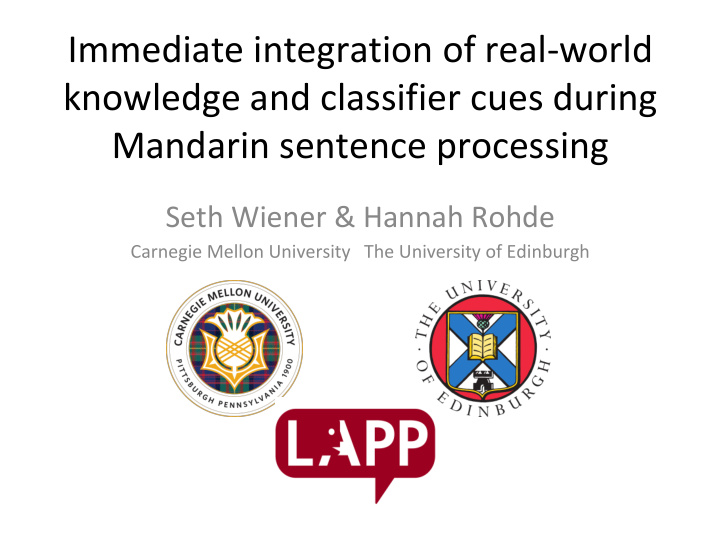



Immediate integration of real-world knowledge and classifier cues during Mandarin sentence processing Seth Wiener & Hannah Rohde Carnegie Mellon University The University of Edinburgh
We have expectations about speech given our surroundings and real-world knowledge Closet/wardrobe contains clothing. Expect jackets, hats, gloves, and scarves in a closet. Would not expect snakes...
We have linguistic knowledge of how morphosyntax constrains such messages’ realization A pair of gloves. liǎng tiáo wéijīn 两条围巾 ‘Two scarves.’ A pound of jackets …
Establishing the meaning of a sentence depends on estimates of both likely messages and likely forms.
How do listeners integrate real-world knowledge with morphosyntax in real time? We examine how native Mandarin listeners integrate • semantic cues derived from contextual knowledge outside the sentence • semantic cues signaled by a noun classifier
Mandarin noun class assignment reflects intrinsic and transparent semantic properties of the object itself, e.g., shape, size (Erbaugh, 2006). Native speakers show awareness of a classifier’s associated semantic properties and use these properties to facilitate processing (Huettig et al., 2010; Klein et al., 2012; Qian & Garnsey, 2016).
Tiáo 条 long, thin objects • liǎng tiáo wéijīn 两条围巾 ‘two scarves’ Dǐng 顶 headwear • sān dǐng màozi 三顶帽子 ‘three hats’ • zhè tiáo xīnwén 这条新闻 ‘this news’ • nà dǐng zhàngpeng 那顶帐篷 ‘that tent’
Classifier comprehension provides an index of anticipatory processing ERP study presented a high-cloze-probability noun Zhang Yimou directed … (Kwon et al., 2017) 张艺谋执导的这 _____________...( 提名了 ) • 部电影 bù diànyǐng EXPECTED [movie] • 座大楼 zuò dàlóu UNRELATED [building] • 场 演出 chǎng yǎnchū RELATED [performance]
What preferences do comprehenders have among upcoming nouns from the same class?
To what degree does contextual knowledge influence this preference? What happens when an object is made salient via the classifier but is ruled out by event semantics?
Eye-tracking experiment 30 native Mandarin speakers (minimally completed 12 years of education in China).
Online norming tasks were carried out to create 24 location-target item sets. Example: • Location: closet ( 衣橱 ) • Target: a scarf ( 一条围巾 ) • Location competitor: a hat ( 一顶帽子 ) • Classifier competitor: a snake ( 一条蛇 ) • Distractor: a watermelon ( 一颗西瓜 )
Headwear classifier
Headwear classifier Spherical classifier
Headwear classifier Flat, long classifier Spherical classifier
Native Mandarin speakers were given instructions, “look in the closet, is there … ” Simultaneous presentation of 4 images and the one classifier target, “yi classifier scarf” Trials were followed by yes/no content questions – fillers did not show image. 56 total trials: 12 context match, 12 context mismatch, and 32 fillers. Match/mismatch trials counterbalanced across 2 lists.
Real-world knowledge: hats/scarves in closet; snakes in swamps; watermelons in markets Morphosyntax: 3 separate classifiers
TARGET
CLASSIFIER COMPETITOR
LOCATION COMPETITOR
DISTRACTOR
What object are listeners looking to at each sample in time?
Closet + scarf = MATCH
Native speakers immediately integrate contextual knowledge with classifier semantic cues. Predictions happen BEFORE acoustic information identifying the noun. What happens if the context doesn’t match expectations? • A snake in the closet!
TARGET
CLASSIFIER COMPETITOR
Closet + snake = MISMATCH
Comprehenders rapidly integrate real-world- knowledge and morphosyntactic-based semantic information during their online sentence processing.
What happens to non-native listeners? Do L2 learners of Mandarin demonstrate the same time course of integration? Do they rely on real-world knowledge to a greater extent?
Additional norming measures to identify 18 sets of items appropriate for L2 learners. Preliminary results based on 8 advanced L2 learners – all of whom had studied abroad in China …
L2 learners seem to be integrating their knowledge and classifier information with similar efficiency! Stay tuned …
Thank you: Lewis (Jieming) Li, Yuan Bing, Youna Song, and Josiah King
Recommend
More recommend